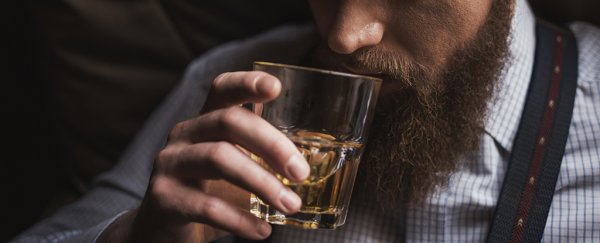Make mine a Laphroaig Islay single malt, at least 18 years in the barrel. Oh, and a side of water. Science says you can wipe that condescending smirk from your face, while you're at it.
A lot of whisky drinkers (or whiskey if you prefer the Irish spelling) will tell you a dash of H2O in their favourite peaty drop will bring out a completely different flavour profile. Just when you thought they couldn't be more pretentious, they can now give you the chemistry to explain it as well.
The discovery was made by a pair of chemists from Linnaeus University in Kalmar, Sweden, who carried out computer simulations on a mixture of water and ethanol in the presence of a spicy-smelling aromatic called guaiacol.
Whisky – or just scotch if you happen be referring to the stuff from the land of haggis and kilts – is basically mushed up, fermented grains that's distilled to about 70 percent alcohol and then aged in a wooden barrel before being diluted and bottled.
Different grains, drying methods, fermentation processes, ageing times, water sources, and even the prior use of the barrel will give you a wide variety of beverages full of flavours and aromas that you can memorise and win friends with by talking about for hours.
As if that wasn't interesting enough, you can play with the profiles of the flavour by changing the temperature, adding a few drops of water, or adding a litre of your favourite cheap mixer.
Why does a drop or two of water make a difference? There are as many opinions on that as there are whiskys.
Some will tell you the water acts as a diluent, dulling the overwhelming taste of alcohol. Others will cite water's ability to dissolve specific compounds, or encourage fatty acids to form tiny bubbles that also separate flavours.
Bjorn Karlsson and Ran Friedman now have an answer backed by research, and in the process ruled out anything to do with fatty acids or easing the burn.
Putting aside the majority of complex organic compounds, the pair made it simple by focussing on the bulk of the mixture; water, ethanol, and the phenol guaiacol.
Guaiacol is the taste of a good whisky. It's the peat of a Scottish moor. The faint wood-smoke in a summer's breeze. A gentle whisper of vanilla, a virgin's kiss of citrus, a sigh of freshly roasted coffee. (Sorry, we're really getting carried away with our tasting session phraseology now.)
Whatever it tastes like to you, the chemical dissolves far better in ethanol than it does water, meaning the ratio of alcohol to H2O in your glass is going to have a significant effect on how much guaiacol is available to your palate.
Above 59 percent ethanol, the aromatic is distributed fairly evenly through the mixture.
Whisky is usually diluted down to roughly 40 percent ethanol before being bottled, though. Computer simulations showed at this concentration ethanol, and with it the guaiacol, floated closer to the surface.
Add a little more water, diluting it down to 27 percent ethanol, and the ethanol could more easily move from the mixture into the air as an aerosol.
This separation means guaiacol loses about half of its contacts with ethanol.
Since it isn't as friendly with the water molecules, the bulk of those aromatic molecules sit forlornly at the top of your glass, pathetically commiserating with your own lost relationships.
"Because this drink is consumed at the interface first, our findings help to understand why adding water to whisky helps to enhance its taste," say Karlsson and Friedman.
Never fear if whisky isn't your drop. The research could easily apply to nearly any mixture that contains water, ethanol, and similar aromatic compounds that behave like guaiacol.
It's entirely possible there is a lot more going on than meets the eye. Karlsson and Friedman don't even drink the stuff, so make of it what you will.
If nothing else, it will give you a chance to pronounce guaiacol while semi-inebriated, just to impress the bartender.
This research was published in Scientific Reports.
